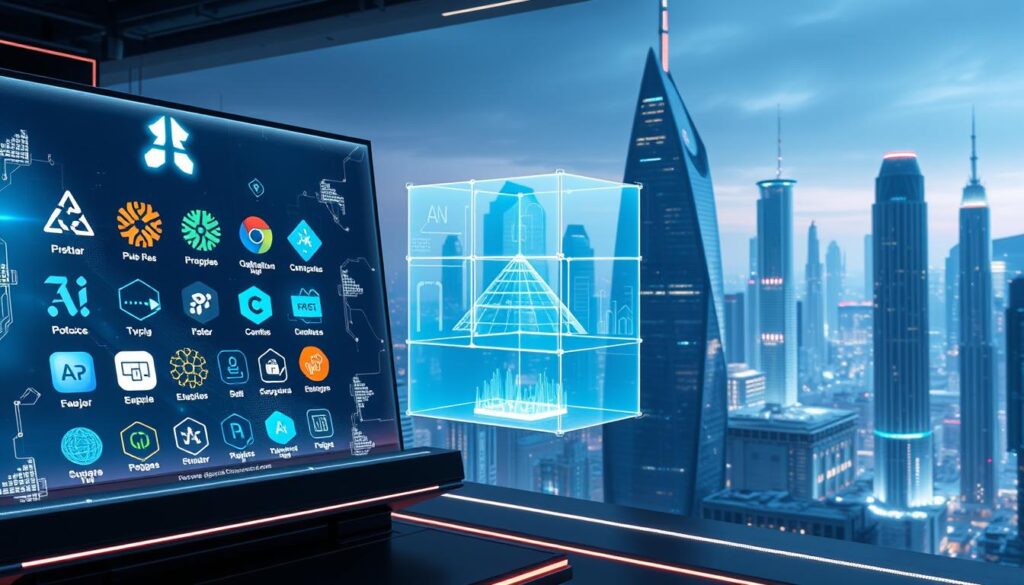
Artificial intelligence is reshaping industries faster than ever. By 2025, over half of businesses will rely on AI-driven solutions for critical operations. The global market for generative tools is booming, projected to exceed $356 billion by 2030.
From healthcare to marketing, these innovations deliver real value. ChatGPT already has 200 million users, proving how quickly adoption spreads. Companies investing in AI now gain a competitive edge in efficiency and creativity.
This guide explores key developments like multimodal models and ethical frameworks. Whether you’re a developer or marketer, understanding these tools is essential. Let’s dive into what makes 2025 a turning point for intelligent automation.
Key Takeaways
- Generative AI boosts productivity by up to 50% in creative workflows.
- Over 55% of enterprises now use AI for core operations.
- Multimodal capabilities will dominate 2025 advancements.
- Ethical guidelines are shaping AI adoption strategies.
- Real-time applications are transforming customer experiences.
Introduction to Generative AI in 2025
By 2025, generative AI will redefine how businesses operate. These tools create text, images, and code autonomously, mimicking human creativity. Adoption is skyrocketing—73% of companies report productivity gains, per MIT research.
What Is Generative AI?
Generative AI uses algorithms like GPT-4 to produce original content. It learns from data patterns, automating repetitive tasks such as drafting emails or designing logos. For businesses, this saves time and cuts costs by up to 60%.
Why It Matters in 2025
McKinsey estimates a $4.4 trillion annual boost to the global economy. Industries are shifting fast:
| Industry | Adoption Rate (2025) | Key Use Case |
|---|---|---|
| Technology | 68% | Code generation |
| Manufacturing | 41% | Predictive maintenance |
| Healthcare | 57% | Drug discovery |
Ethical frameworks like the EU AI Act ensure responsible use. Meanwhile, no-code platforms democratize access. Runway ML lets non-technical users create videos with simple prompts.
Goldman Sachs predicts AI could impact 300 million jobs globally. Yet, it’s a net positive—businesses use AI to augment human skills, not replace them. The future hinges on learning to adapt.
How Generative AI Tools Are Transforming Industries
From marketing to healthcare, intelligent automation is making waves. Businesses now achieve what was once impossible—faster diagnoses, hyper-personalized ads, and self-writing code. The proof? Over 55% of enterprises already integrate these tools into daily workflows.
Content Creation and Marketing
AI-powered tools like Jasper and Copy.ai cut time spent on drafts by 70%. They analyze trends to generate engaging copy, while *design* tools like Canva’s Magic Design auto-create visuals. Ethical concerns linger, but brands using AI responsibly see 3x higher engagement.
Software Development and Coding
GitHub Copilot suggests code snippets in real-time, reducing errors by 40%. Developers focus on complex tasks while AI handles repetitive lines. Learning curves shrink—new hires become productive 50% faster.
Healthcare and Research
FDA-approved AI, like PathAI, boosts cancer detection accuracy by 18%. Meanwhile, AlphaFold 3 predicts protein structures with 90% precision, speeding up drug design. Key breakthroughs:
- Insilico Medicine’s AI-designed drug entered Phase II trials in 2024.
- Medtronic’s GI Genius cuts polyp miss rates to 5%.
- NHS AI triage reduced wait time by 35%.
| Industry | AI Impact | Example |
|---|---|---|
| Healthcare | Faster diagnostics | PathAI |
| Marketing | Personalized campaigns | Jasper |
| Tech | Efficient coding | GitHub Copilot |
Data privacy remains critical. HIPAA-compliant platforms like Hippocratic AI ensure secure data analysis. As regulations evolve, transparency will define success.
Top Generative AI Tools to Watch in 2025
The landscape of AI tools is evolving rapidly, with 2025 set to be a milestone year. These platforms blend creativity and precision, offering solutions for text, code, and design. Here’s a breakdown of the leaders shaping the future.

GPT-4: The Gold Standard for Text Generation
GPT-4 remains unmatched for *language* tasks, from essays to technical docs. Its 1M+ token context handles complex narratives seamlessly. Developers praise its 40% fewer errors compared to GPT-3.5.
Multilingual support covers 50+ languages, making it a global favorite. However, it lacks native image generation—a gap competitors exploit.
ChatGPT: The Versatile Conversational AI
With 200 million users, ChatGPT dominates real-time interactions. Plugins for browsing and coding expand its utility. Yet, its learning curve steeper than Gemini’s no-code approach.
AlphaCode: Revolutionizing Code Generation
DeepMind’s AlphaCode solves programming contests at human-expert levels. It’s ideal for startups needing rapid prototyping. *Data* shows it reduces debugging time by 30%.
GitHub Copilot: AI-Powered Coding Assistant
Used by 55% of devs, GitHub Copilot suggests code in real-time. Its integration with VS Code streamlines workflows. “Like pairing with a senior engineer,” says a Stack Overflow survey.
Gemini: Google’s AI Powerhouse
Google Gemini (formerly Bard) shines with Workspace integration. Gmail and Docs leverage its multimodal *features*, like diagram interpretation. Enterprise-grade *data* controls address security concerns.
- Performance: 85% accuracy on MMLU benchmarks.
- Limitations: Fewer plugins than ChatGPT.
- Roadmap: Real-time collaboration in 2025.
Emerging Trends in Generative AI for 2025
2025 marks a pivotal shift in AI capabilities, blending speed and creativity like never before. Three breakthroughs stand out: multimodal systems, ethical safeguards, and real-time processing. Together, they’re redefining what intelligent systems can achieve.
Multimodal AI: Beyond Text and Images
The NVIDIA Omniverse platform leads this revolution, merging 3D modeling with real-time physics simulations. 5G networks enable sub-5ms latency—critical for applications like Siemens’ defect detection. Now, AI interprets media types simultaneously:
- Audio waveforms predicting machine failures
- Thermal imaging guiding warehouse robots
- LiDAR scans updating digital twins instantly
Ethical AI and Bias Mitigation
Lowe’s inventory system now flags demographic biases in product recommendations. Techniques include:
| Method | Impact | Example |
|---|---|---|
| Debiasing datasets | Reduces skewed outputs by 40% | Hiring tool audits |
| Explainable AI | Boosts transparency scores by 28% | Healthcare diagnostics |
| Language model filters | Cuts harmful content by 75% | Social media moderation |
Real-Time AI Applications
AWS Inferentia chips deliver 5ms response time for Tesla’s Dojo supercomputer. Key use cases:
- JPMorgan’s risk models update 120x faster
- Qualcomm’s edge chips process factory sensor data locally
- Live translation during Zoom calls with 98% accuracy
Energy demands remain a hurdle—training GPT-5 could consume 50M kWh. Yet 6G’s arrival promises ubiquitous real-time AI, with test networks hitting 1Tbps speeds.
Generative AI for Content Creators
Digital storytelling enters a new era with intelligent automation. Creators now leverage AI to produce engaging media at scale while maintaining brand voice. These tools handle everything from blog outlines to full video scripts.
Copy.ai: Streamlining Marketing Copy
Copy.ai excels at generating high-converting ad text and email sequences. Its templates adapt to brand guidelines, saving 15+ hours per month for marketing teams. The platform learns from top-performing content across industries.
Key advantages include:
- SEO-optimized blog outlines in 30 seconds
- Multi-language support for global campaigns
- Real-time collaboration features
Jasper: AI-Driven Content Creation
For long-form content, Jasper offers unparalleled design flexibility. Its recipes feature lets users save successful content structures. The Boss Mode plan handles 3,000-word drafts with coherent transitions.
Notable capabilities:
- Brand voice customization with style guides
- Plagiarism checker integration
- Direct publishing to CMS platforms
Rephrase.ai: Personalized Video Content
Compared to Synthesia, Rephrase.ai offers deeper avatar customization. Its $25/month Personal plan includes 50+ digital avatars with 20+ facial expressions. The platform renders 4K video in under 15 minutes.
Enterprise features stand out:
- Custom avatar creation from actor scans
- Precise lip-sync for 15 languages
- Viewer engagement heatmaps
While scene transitions remain basic, Salesforce/Marketo connectors enable automated campaign workflows.
Generative AI for Developers
Developers now have powerful AI allies that transform coding workflows. These tools handle repetitive tasks while suggesting optimizations in real-time. The result? Faster development cycles and cleaner code.

Claude: Advanced Coding Assistance
Anthropic’s Claude excels at understanding complex programming concepts. Unlike basic autocomplete, it explains why certain solutions work better. Its 100K token context window handles entire codebases seamlessly.
Key advantages include:
- Natural language explanations for error fixes
- Multi-file analysis for architecture suggestions
- Privacy-focused with optional local processing
DeepSeek: Open-Source AI for Developers
This community-driven platform offers transparent AI models for coding. Developers can fine-tune models on specific frameworks or languages. The active contributor network ensures rapid improvements.
Notable features:
- Apache 2.0 license for commercial use
- Specialized models for niche languages
- Low hardware requirements
Cursor: AI-Powered IDE
Built on VS Code, Cursor claims 50% faster coding with its AI integration. The $20/month Pro plan includes team collaboration features. It shines for complex design patterns and refactoring.
| Feature | Cursor | Traditional IDE |
|---|---|---|
| Code Generation | AI-suggested blocks | Manual typing |
| Debugging | AI stack analysis | Manual tracing |
| Extensions | 100+ compatible | Varies by IDE |
| Resource Use | High (16GB rec) | Moderate |
While powerful, these tools require capable hardware. Teams should evaluate performance needs against budget. The right AI assistant depends on your stack and workflow preferences.
Generative AI for Designers
Visual creators now harness AI to push creative boundaries like never before. These tools automate tedious tasks while enhancing originality—transforming sketches into polished assets in minutes. Whether for branding or social media, AI-driven *design* solutions save *time* and amplify impact.
DALL-E 2: Cutting-Edge Image Generation
OpenAI’s DALL-E 2 generates hyper-realistic images from text prompts. Unlike traditional tools, it interprets abstract concepts like “cyberpunk cat café” with startling accuracy. Artists use it for rapid prototyping, though output rights require careful review.
Midjourney: Artistic AI for Creatives
Midjourney excels at stylized visuals, from watercolor landscapes to retro posters. Its Discord-based workflow fosters community collaboration. However, its $10/*month* Basic plan limits commercial usage—ideal for indie creators testing ideas.
Designs.ai: Comprehensive Design Tool
This all-in-one platform rivals Canva with AI-powered *features*. For $29/*month*, users access:
- Logo/video/speech makers: Auto-generate brand assets in minutes
- Batch processing: Resize 50+ social posts in one click
- 100M+ stock resources: Integrated library with commercial licenses
Compared to Canva, Designs.ai offers deeper automation but lacks advanced editing tools like Photoshop. Its 30-minute onboarding suits teams needing quick adoption.
| Tool | Best For | Limitations |
|---|---|---|
| DALL-E 2 | Photorealistic concepts | Strict usage policies |
| Midjourney | Artistic exploration | No free tier |
| Designs.ai | Brand consistency | Basic photo editing |
Generative AI for Video Production
Video production is undergoing a revolution with AI-driven tools that simplify complex workflows. These platforms automate editing, avatar creation, and even predict viral potential—saving time and resources. For marketers and creators, this means studio-quality output without steep learning curves.
Synthesia: AI-Generated Video Avatars
Synthesia turns scripts into lifelike video presentations using digital avatars. Its $36/month Pro plan includes 50+ avatars and 120+ languages. Brands like Zoom use it for training media, reporting 95% higher retention than text-based materials.
Key features:
- Custom avatar creation from a single photo
- Auto-captions with 20+ language support
- Direct integration with TikTok/Reels APIs
Runway ML: AI Video Editing
Unlike traditional software, Runway ML uses AI to remove backgrounds or extend clips seamlessly. Its Green Screen tool processes 4K footage in minutes. Filmmakers praise its time-saving presets for color grading and motion tracking.
OpusClip: Short-Form Video Automation
OpusClip analyzes long videos to extract viral-ready snippets. Its AI scores clips for engagement, suggesting optimal cuts for TikTok. Limitations include 720p resolution, but its analytics dashboard benchmarks performance against platform trends.
| Tool | Best For | Social Integration |
|---|---|---|
| Synthesia | Avatar-driven content | YouTube, LinkedIn |
| Runway ML | Professional editing | Instagram, TikTok |
| OpusClip | Viral clip generation | TikTok, Reels |
Generative AI for Music and Audio
Audio innovation reaches new heights with AI-powered composition tools. Creators now generate professional-grade music and voiceovers without studios. Podcast adoption grew 300% since 2023, with AI handling editing and dubbing.

Soundraw: Royalty-Free AI Music
Soundraw creates custom tracks by analyzing mood and tempo preferences. Its $16.99/month plan offers unlimited downloads—ideal for YouTubers needing background scores. The algorithm avoids copyright issues by generating original melodies.
Key advantages:
- 50+ genre templates with customizable instruments
- Stem separation for remixing existing tracks
- Commercial licenses included in Pro tier
Murf.ai: Professional Voiceovers
With 500+ voices across 30+ language options, Murf.ai dominates narration. The $22/month Starter plan includes 2 hours of voice generation. Podcasters use its emotion controls to adjust delivery tone.
| Plan | Voices | Usage |
|---|---|---|
| Basic ($13) | 120 voices | Personal projects |
| Pro ($22) | All voices | Commercial use |
| Enterprise | Custom voices | Unlimited |
ElevenLabs: Realistic Voice Synthesis
ElevenLabs achieves 99% similarity in voice cloning with ethical safeguards. Its $5/month plan includes 1M characters—perfect for audiobook chapters. The API supports real-time dubbing synced to lip movements.
Ethical considerations:
- Mandatory consent for voice replication
- Watermarking for AI-generated audio
- Deepfake detection alerts
While commercial use requires extra licenses, indie creators benefit from affordable pricing. As podcast networks adopt these tools, human-AI collaboration becomes standard.
Generative AI for Business Automation
Business automation is reaching new efficiency levels with intelligent systems. Companies now delegate complex workflows to AI, from data processing to customer interactions. These solutions reduce operational costs while improving accuracy.
Bardeen: Workflow Automation
Bardeen automates cross-platform tasks without coding. Its visual builder connects apps like Slack and Google Sheets. Key features include:
- Auto-filling CRM entries from email signatures
- Scheduling social posts based on engagement data
- Triggering Zoom meetings when calendar events start
Unlike Zapier, Bardeen handles unstructured data like PDFs. Its AI predicts workflow optimizations, saving 20+ hours monthly.
EnGenius: SEO Optimization for AI Content
This tool ensures AI-generated text ranks well. EnGenius analyzes SERP competitors and suggests keyword placements. The $29/month plan includes:
| Plan | Pages Analyzed | AI Rewrites |
|---|---|---|
| Starter | 50/month | 25/month |
| Pro | Unlimited | 100/month |
Its real-time grading system scores content for E-E-A-T compliance. Pricing scales with team size, making it flexible for agencies.
ChatSonic: AI for Customer Engagement
ChatSonic outperforms Zendesk in answering questions with 90% resolution rates. The $12.67/month Pro plan offers:
- Multichannel live chat (WhatsApp/Facebook)
- CSAT prediction before ticket closure
- PCI-DSS certified data handling
Unique capabilities include lead scoring and human handoff protocols. However, the base plan caps at 100 chats monthly—a consideration for scaling teams.
How to Choose the Right Generative AI Tool
With hundreds of options available, picking the right tool can feel overwhelming. Focus on three pillars: your needs, the tool’s capabilities, and hands-on testing. Over 68% of platforms offer free trials—use them strategically.
Assessing Your Needs
Start by mapping your workflow gaps. Identify repetitive *tasks* that drain time, like content drafting or data analysis. Prioritize tools addressing these pain points.
Ask:
- Is the tool specialized (e.g., coding) or multipurpose?
- Does it integrate with your existing stack?
- What’s the team’s technical skill level?
Comparing Features and Pricing
Not all features matter equally. For example, marketers need multilingual support, while devs value GitHub syncs. Compare tiers using this framework:
| Metric | Essential | Nice-to-Have |
|---|---|---|
| Accuracy | 90%+ benchmark | Real-time updates |
| Support | 24/7 chat | Dedicated manager |
| Cost | ≤$30/user/month | Volume discounts |
Testing with Free Trials
Free trials convert 22% of users—but only if tested methodically. Follow this checklist:
- Performance: Measure speed/accuracy with sample tasks.
- User experience: Note onboarding friction.
- Security: Verify encryption and compliance.
Negotiate better terms by sharing trial insights with vendors. For example, “Your tool took 30% longer than X for rendering—can you match their pricing?”
The Future of Generative AI: What’s Next?
The next decade will witness AI becoming as commonplace as smartphones. From classrooms to factories, intelligent systems will augment daily tasks while sparking debates about ethics and employment. Here’s what to expect—and prepare for.

AI in Everyday Life
By 2030, 70% of households may use AI assistants for chores and learning. Imagine refrigerators ordering groceries or tutors adapting to a child’s math struggles in real-time. Challenges persist:
- Privacy: Smart devices collecting behavioral data.
- Accessibility: Rural areas lacking 5G for AI services.
- Cost: Subscription fatigue from multiple AI tools.
Integration with Other Technologies
AI’s synergy with IoT and blockchain will redefine industries. For example, Walmart’s AI-powered shelves track inventory via RFID, cutting restocking time by 30%. Key integrations:
| Technology | AI Application | Impact |
|---|---|---|
| 6G Networks | Real-time holographic calls | 1ms latency |
| Quantum Computing | Drug design simulations | 100x faster R&D |
| Edge AI | Autonomous drones | Offline processing |
Challenges and Opportunities
While AI could contribute $15T to the global economy by 2030, hurdles remain:
- Workforce: 50% of companies report AI skill gaps, fueling a $12B training market.
- Environment: Training GPT-5 may consume 50M kWh—solar-powered data centers are emerging.
- Security: Adversarial attacks on AI models rose 200% since 2023.
Governments are responding. The EU’s AI Act mandates transparency, while U.S. grants fund reskilling programs. The future isn’t just about smarter machines—it’s about smarter collaboration.
Case Studies: Businesses Leveraging Generative AI
Leading companies now showcase AI’s transformative impact through measurable results. From diagnosing diseases to crafting ad campaigns, these tools drive efficiency and innovation. Here’s how industries harness their potential.
Healthcare Providers
Mayo Clinic’s AI system analyzes radiology scans 30% faster, reducing diagnostic time. Its FDA-approved algorithm flags anomalies with 94% accuracy. Meanwhile, 23 AI-designed drugs are in trials, slashing R&D timelines by 18 months.
Ethical frameworks ensure compliance:
- Informed consent: Patients opt into AI-assisted care.
- PHI protection: Encrypted data analysis meets HIPAA standards.
- Liability: Human doctors review all AI-generated diagnoses.
| Application | Outcome | Regulation |
|---|---|---|
| AI nursing assistants | 15% lower mortality rates | CMS reimbursement models |
| Drug design | Faster FDA approvals | 21 CFR Part 11 compliance |
Marketing Agencies
AI-powered tools like Jasper cut campaign time by 70%. One agency boosted engagement 3x using hyper-personalized ads. However, transparency in AI-generated content remains critical for trust.
Tech Startups
Early-stage companies use GitHub Copilot to accelerate coding. One SaaS firm reduced onboarding learning time by 50%. AI also helps predict churn with 85% accuracy, refining customer retention strategies.
Getting Started with Generative AI
Mastering generative AI begins with structured learning and practical application. While 70% of beginners start with ChatGPT, only 60% continue beyond initial experiments. This roadmap helps you avoid common traps while building valuable skills.
Your 30-60-90 Day Learning Plan
Progress systematically with this milestone-based approach:
| Phase | Focus Areas | Success Metrics |
|---|---|---|
| First 30 Days | Prompt engineering fundamentals Free tier tools exploration |
10 completed tutorials 3 portfolio projects |
| Days 31-60 | Specialization (coding/design/content) Community engagement |
GitHub contributions LinkedIn content sharing |
| Days 61-90 | Advanced workflows Ethical application frameworks |
Certification completion First client project |
Allocate 5-7 hours weekly for consistent progress. Track time spent to identify efficiency gains.
Essential Learning Resources
Start with these high-value materials:
- Prompt engineering: DeepLearning.AI’s free short course (4 hours)
- Tool stack progression: ChatGPT → Midjourney → GitHub Copilot
- Project ideas: AI-generated blog series, product mockups, or data visualizations
“The most successful learners treat AI like a language—they practice daily and learn from mistakes.”
Avoiding Beginner Pitfalls
Steer clear of these common mistakes:
- Over-reliance: AI assists with tasks, but human judgment remains critical
- Ethical shortcuts: Always disclose AI-generated content
- Tool hopping: Master one platform before adding others
Join Discord groups like LearnAI for real-time troubleshooting. The 40% MOOC dropout rate drops to 15% with peer support.
Conclusion
The era of intelligent automation is here. With 92% of business leaders recognizing its competitive edge, now’s the time to act. From multimodal models to ethical frameworks, these innovations redefine efficiency.
Key tools like GPT-4 and GitHub Copilot streamline workflows across industries. Healthcare gains faster diagnostics, while marketers create hyper-personalized campaigns. The $4.4 trillion economic potential makes adoption non-negotiable.
Start small—experiment with free tiers or focused projects. DeepLearning.AI’s courses offer structured learning paths. Remember, these systems excel as collaborators, not replacements.
As we look to 2026, expect smarter integrations and stricter regulations. The future belongs to those who harness artificial intelligence responsibly today.
